Class 6: Maths Chapter 10 solutions. Complete Class 6 Maths Chapter 10 Notes.
Contents
NCERT Solutions for 6th Class Maths: Chapter 10-Mensuration
NCERT 6th Maths Chapter 10, class 6 Maths Chapter 10 solutions
Exercise 10.1
1. Find the perimeter of each of the following figures: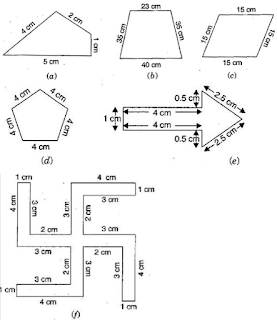
Answer
(a) Perimeter = Sum of all the sides
= 4 cm + 2 cm + 1 cm + 5 cm
= 12 cm
(b) Perimeter = Sum of all the sides
= 23 cm + 35 cm + 40 cm + 35 cm
= 133 cm
(c) Perimeter = Sum of all the sides
= 15 cm + 15 cm + 15 cm + 15 cm
= 60 cm
(d) Perimeter = Sum of all the sides
= 4 cm + 4 cm + 4 cm + 4 cm + 4 cm
= 20 cm
(e) Perimeter = Sum of all the sides
= 1 cm + 4 cm + 0.5 cm + 2.5 cm + 2.5 cm + 0.5 cm + 4 cm
= 15 cm
(f) Perimeter = Sum of all the sides
= 4 cm + 1 cm + 3 cm + 2 cm + 3 cm + 4 cm + 1 cm + 3 cm + 2 cm + 3 cm + 4 cm +
1 cm + 3 cm + 2 cm + 3 cm + 4 cm + 1 cm + 3 cm + 2 cm + 3 cm
= 52 cm
2. The lid of a rectangular box of sides 40 cm by 10 cm is sealed all round with tape. What is the length of the tape required?
Answer
Total length of tape required = Perimeter of rectangle
= 2 ( length + breadth)
= 2 ( 40 + 10)
= 2×50
= 100 cm = 1 m
Thus, the total length of tape required is 100 cm or 1 m.
3. A table-top measures 2 m 25 cm by 1 m 50 cm. What is the perimeter of the table-top?
Answer
Length of table top = 2 m 25 cm = 2.25 m
Breadth of table top = 1 m 50 cm = 1.50 m
Perimeter of table top = 2 x (length + breadth)
= 2 × (2.25 + 1.50)
= 2 × 3.75 = 7.50 m
Thus, perimeter of table top is 7.5 m.
4. What is the length of the wooden strip required to frame a photograph of length 32 cm and breadth 21 cm respectively?
Answer
Length of wooden strip = Perimeter of photograph
Perimeter of photograph = 2 × (length + breadth)
= 2 (32 + 21)
= 2 × 53 cm = 106 cm
Thus, the length of the wooden strip required is 106 cm.
5. A rectangular piece of land measures 0.7 km by 0.5 km. Each side is to be fenced with 4 rows of wires. What is the length of the wire needed?
Answer
Since the 4 rows of wires are needed. Therefore the total length of wires is equal to 4 times the perimeter of rectangle.
Perimeter of rectangular piece of land = 2 × (length + breadth)
= 2 × (0.7 + 0.5)
= 2 × 1.2
= 2.4 km
= 2.4 × 1000 m
= 2400 m
Thus, the length of wire = 4 × 2400 = 9600 m = 9.6 km
6. Find the perimeter of each of the following shapes:
(a) A triangle of sides 3 cm, 4 cm and 5 cm.
(b) An equilateral triangle of side 9 cm.
(c) An isosceles triangle with equal sides 8 cm each and third side 6 cm.
Answer
(a) Perimeter of ΔABCΔABC = AB + BC + CA

= 3 cm + 5 cm + 4 cm = 12 cm
(b) Perimeter of equilateral ΔABCΔABC = 3×side

= 3×9 cm = 27 cm
(c) Perimeter of ΔABCΔABC = AB + BC + CA

= 8 cm + 6 cm + 8 cm = 22 cm
7. Find the perimeter of a triangle with sides measuring 10 cm, 14 cm and 15 cm.
Answer
Perimeter of triangle = Sum of all three sides
= 10 cm + 14 cm + 15 cm = 39 cm
Thus, perimeter of triangle is 39 cm.
8. Find the perimeter of a regular hexagon with each side measuring 8 cm.
Answer
Perimeter of Hexagon = 6 × length of one side
= 6 x 8 m = 48 m
Thus, the perimeter of hexagon is 48 m.
9. Find the side of the square whose perimeter is 20 m.
Answer
Perimeter of square = 4 × side
⇒ 20 = 4 × side
⇒ side = 20/4 = 5 cm
Thus, the side of square is 5 cm.
10. The perimeter of a regular pentagon is 100 cm. How long is its each side?
Answer
Perimeter of regular pentagon = 100 cm
⇒ 5 × side = 100 cm
⇒ side = 100/5 = 20 cm
Thus, the side of regular pentagon is 20 cm.
11. A piece of string is 30 cm long. What will be the length of each side if the string is used to form:
(a) a square
(b) an equilateral triangle
(c) a regular hexagon?
Answer
Length of string = Perimeter of each figure
(a) Perimeter of square = 30 cm
⇒ 4 × side = 30 cm
⇒ side = 30/4 = 7.5 cm
Thus, the length of each side of square is 7.5 cm.
(b) Perimeter of equilateral triangle = 30 cm
⇒ 3 × side = 30 cm
⇒ side = 30/3 = 10 cm
Thus, the length of each side of equilateral triangle is 10 cm.
(c) Perimeter of hexagon = 30 cm
⇒ 6 × side = 30 cm
⇒ side = 30/6 = 5 cm
Thus, the length of each side of hexagon is 5 cm.
12. Two sides of a triangle are 12 cm and 14 cm. The perimeter of the triangle is 36 cm. What is the third side?
Answer
Let the length of third side be xx cm.
Length of other two side are 12 cm and 14 cm.
Now, Perimeter of triangle = 36 cm
⇒ 12+14+x = 36
⇒ 26+x = 6
⇒ x = 36−26
⇒ x=10
Thus, the length of third side is 10 cm.
13. Find the cost of fencing a square park of side 250 m at the rate of Rs 20 per meter.
Answer
Side of square = 250 m
Perimeter of square = 4 × side
= 4 × 250 = 1000 m
Since, cost of fencing per meter = Rs. 20
Therefore, cost of fencing of 1000 meters = 20×1000 = Rs. 20,000
14. Find the cost of fencing a rectangular park of length 175 m and breadth 125 m at the rate of Rs. 12 per meter.
Answer
Length of rectangular park = 175 m
Breadth of rectangular park = 125 m
Perimeter of park = 2 x (length + breadth)
= 2 × (175 + 125)
= 2×300 = 600 m
Since, cost of fencing park per meter = Rs. 12
Therefore, cost of fencing park of 600 m = 12×600 = Rs. 7,200
15. Sweety runs around a square park of side 75 m. Bulbul runs around a rectangular park with length of 60 m and breadth 45 m. Who covers less distance?
Answer
Distance covered by Sweety = Perimeter of square park
Perimeter of square = 4×side
= 4×75 = 300 m
Thus, distance covered by Sweety is 300 m.
Now, distance covered by Bulbul = Perimeter of rectangular park
Perimeter of rectangular park = 2×(length + breadth)
= 2×(60 + 45)
= 2×105 = 210 m
Thus, Bulbul covers the distance of 210 m.
So, Bulbul covers less distance.
16. What is the perimeter of each of the following figures? What do you infer from the answer?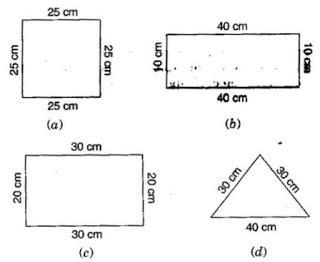
Answer
(a) Perimeter of square = 4×side
= 4×25 = 100 cm
(b) Perimeter of rectangle = 2×(length + breadth)
= 2×(40 + 10)
= 2×50 = 100 cm
(c) Perimeter of rectangle = 2×(length + breadth)
= 2×(30 + 20)
= 2×50 = 100 cm
(d) Perimeter of triangle = Sum of all sides
= 30 cm + 30 cm + 40 cm = 100 cm
Thus, all the figures have same perimeter.
17. Avneet buys 9 square paving slabs, each with a side 1212 m. He lays them in the form of a square
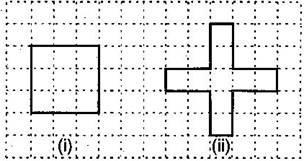
(a) What is the perimeter of his arrangement?
(b) Shari does not like his arrangement. She gets him to lay them out like a cross. What is the perimeter of her arrangement?
(c) Which has greater perimeter?
(d) Avneet wonders, if there is a way of getting an even greater perimeter. Can you find a way of doing this? (The paving slabs must meet along complete edges, i.e., they cannot be broken.)
Answer
(a) 6 m
(b) 10 m
(c) Second arrangement has greater perimeter.
(d) Yes, if all the squares are arranged in row, the perimeter be 10 cm.
NCERT 6th Maths Chapter 10, class 6 Maths Chapter 10 solutions
Exercise 10.2
1. Find the areas of the following figures by counting squares:
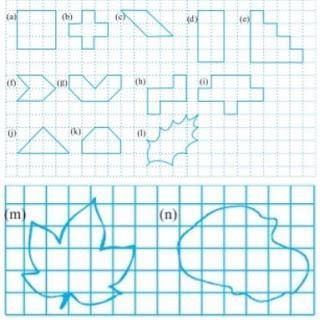
Answer
(a) Number of filled square = 9
Area covered by squares = 9 × 1 = 9 sq. units
(b) Number of filled squares = 5
Area covered by filled squares = 5 × 1 = 5 sq. units
(c) Number of full filled squares = 2
Number of half filled squares = 4
Area covered by full filled squares = 2 × 1 = 2 sq. units
And, Area covered by half filled squares = 1/2 ×4 = 2 sq. units
Total area = 2 + 2 = 4 sq. units
(d) Number of filled squares = 8
Area covered by filled squares = 8 × 1 = 8 sq. units
(e) Number of filled squares = 10
Area covered by filled squares = 10 × 1 = 10 sq. units
(f) Number of full filled squares = 2
Number of half filled squares = 4
Area covered by full filled squares = 2 × 1 = 2 sq. units
And Area covered by half filled squares = 1/2 ×4 = 2 sq. units
Total area = 2 + 2 = 4 sq. units
(g) Number of full filled squares = 4
Number of half filled squares = 4
Area covered by full filled squares = 4 × 1 = 4 sq. units
And, Area covered by half filled squares = 1/2 ×4 = 2 sq. units
Total area = 4 + 2 = 6 sq. units
(h) Number of filled squares = 5
Area covered by filled squares = 5 × 1 = 5 sq. units
(i) Number of filled squares = 9
Area covered by filled squares = 9 × 1 = 9 sq. units
(j) Number of full filled squares = 2
Number of half filled squares = 4
Area covered by full filled squares = 2 × 1 = 2 sq. units
And Area covered by half filled squares = 1/2 ×4 = 2 sq. units
Total area = 2 + 2 = 4 sq. units
(k) Number of full filled squares = 4
Number of half filled squares = 2
Area covered by full filled squares = 4 × 1 = 4 sq. units
And Area covered by half filled squares = 1/2 ×2 = 1 sq. units
Total area = 4 + 1 = 5 sq. units
(l) Number of full filled squares = 3
Number of half filled squares = 10
Area covered by full filled squares = 3 × 1 = 3 sq. units
And Area covered by half filled squares = 1/2 ×10 = 5 sq. units
Total area = 3 + 5 = 8 sq. units
(m) Number of full filled squares = 7
Number of half filled squares = 14
Area covered by full filled squares = 7 × 1 = 7 sq. units
And Area covered by half filled squares = 1/2 ×14 = 7 sq. units
Total area = 7 + 7 = 14 sq. units
(n) Number of full filled squares = 10
Number of half filled squares = 16
Area covered by full filled squares = 10 × 1 = 10 sq. units
And Area covered by half filled squares = 1/2 ×16 = 8 sq. units
Total area = 10 + 8 = 18 sq. units
NCERT 6th Maths Chapter 10, class 6 Maths Chapter 10 solutions
Exercise 10.3
1. Find the areas of the rectangles whose sides are:
(a) 3 cm and 4 cm
(b) 12 m and 21 m
(c) 2 km and 3 km
(d) 2 m and 70 cm
Answer
(a) Area of rectangle = length × breadth
= 3 cm × 4 cm = 12 cm2
(b) Area of rectangle = length × breadth
= 12 m × 21 m = 252 m2
(c) Area of rectangle = length × breadth
= 2 km × 3 km = 6 km2
(d) Area of rectangle = length × breadth
= 2 m × 70 cm = 2 m × 0.7 m = 1.4 m2
2. Find the areas of the squares whose sides are:
(a) 10 cm (b) 14 cm (c) 5 m
Answer
(a) Area of square = side × side
= 10 cm × 10 cm = 100 cm2
(b) Area of square = side x side
= 14 cm × 14 cm = 196 cm2
(c) Area of square = side x side
= 5 m × 5 m = 25 m2
3. The length and the breadth of three rectangles are as given below:
(a) 9 m and 6 m
(b) 17 m and 3 m
(c) 4 m and 14 m
Which one has the largest area and which one has the smallest?
Answer
(a) Area of rectangle = length × breadth
= 9 m × 6 m = 54 m2
(b) Area of rectangle = length × breadth
= 3 m × 17 m = 51 m2
(c) Area of rectangle = length x breadth
= 4 m × 14 m = 56 m2
Thus, the rectangle (c) has largest area, i.e. 56 m2 and rectangle (b) has smallest area, i.e., 51 m2.
4. The area of a rectangular garden 50 m long is 300 m2, find the width of the garden.
Answer
Length of rectangle = 50 m and Area of rectangle = 300 m2
Since, Area of rectangle = length x breadth
Therefore, Breadth =  =300/50 = 6 m
=300/50 = 6 m
Thus, the breadth of the garden is 6 m.
5. What is the cost of tiling a rectangular plot of land 500 m long and 200 m wide at the rate of Rs. 8 per hundred sq. m?
Answer
Length of land = 500 m and Breadth of land = 200 m
Area of land = length x breadth = 500 m × 200 m = 1,00,000 m2
∵ Cost of tiling 100 sq. m of land = Rs. 8
∴ Cost of tilling 1,00,000 sq. m of land = 8/100 ×100000 = Rs. 8000
6. A table-top measures 2 m by 1 m 50 cm. What is its area in square meters?
Answer
Length of table = 2 m and breadth of table = 1 m 50 cm = 1.50 m
Area of table = length × breadth
= 2 m × 1.50 m = 3 m2
7. A room is 4 m long and 3 m 50 cm wide. How many square meters of carpet is needed to cover the floor of the room?
Answer
Length of room = 4 m and breadth of room = 3 m 50 cm = 3.50 m
Area of carpet = length × breadth
= 4 × 3.50 = 14m2
Therefore, 14m2 of carpet required to cover the floor.
8. A floor is 5 m long and 4 m wide. A square carpet of sides 3 m is laid on the floor. Find the area of the floor that is not carpeted.
Answer
Length of floor = 5 m and breadth of floor = 4 m
Area of floor = length × breadth
= 5 m × 4 m = 20 m2
Now, Side of square carpet = 3 m
Area of square carpet = side x side = 3 × 3 = 9 m2
Area of floor that is not carpeted = 20 m2 – 9 m2 = 11 m2
9. Five square flower beds each of sides 1 m are dug on a piece of land 5 m long and 4 m wide. What is the area of the remaining part of the land?
Answer
Side of square bed = 1 m
Area of square bed = side × side = 1 m × 1 m = 1 m2
∴ Area of 5 square beds = 1 × 5 = 5 m2
Now, Length of land = 5 m and breadth of land = 4 m
∴ Area of land = length × breadth = 5 m × 4 m = 20 m2
Area of remaining part = Area of land – Area of 5 flower beds
= 20 m2 – 5 m2 = 15 m2
10. By splitting the following figures into rectangles, find their areas. (The measures are given in centimeters)
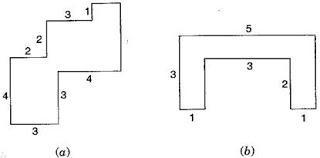
Answer
(a) The given figure can be broken into rectangles as

Area of 1st rectangle = 12 × 2 = 24 cm2
Area of 2nd rectangle = 8 × 2 = 16 cm2
Total area of the figure = 24 + 16 = 40 cm2
(b) The given figure can be broken into rectangles as follow

Area of 1st rectangle = 21 × 7 = 147 cm2
Area of 1st square = 7 × 7 = 49 cm2
Area of 2nd square = 7 × 7 = 49 cm2
Total area of the figure = 147 + 49 + 49 = 245 cm2
(c) The given figure can be broken into rectangles as follow

Area of 1st rectangle = 5 × 1 = 5 cm2
Area of 2nd rectangle = 4 × 1 = 4 cm2
Total area of the figure = 5 + 4 = 9 cm2
11. Split the following shapes into rectangles and find their areas. (The measures are given in centimetres)
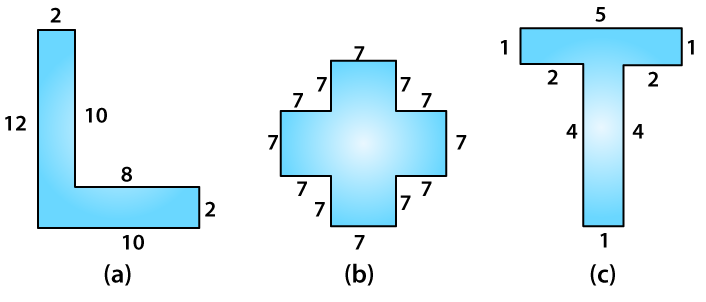
Answer
(a)
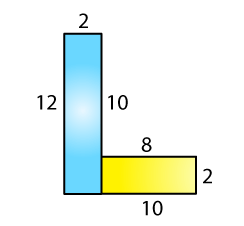
Total area of the figure = 12 × 2 + 8 × 2
= 40 cm2
(b)
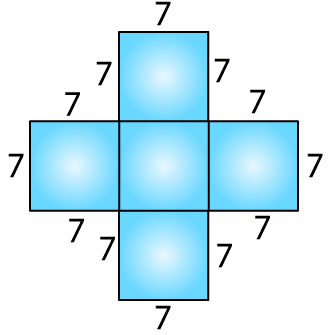
There are 5 squares. Each side is 7 cm
Area of 5 squares = 5 × 72
= 245 cm2
(c)
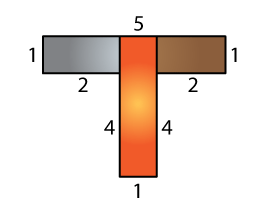
Area of grey rectangle = 2 × 1
= 2 cm2
Area of brown rectangle = 2 × 1
= 2 cm2
Area of orange rectangle = 5 × 1
= 5 cm2
Total area = 2 + 2 + 5
= 9 cm2
12. How many tiles whose length and breadth are 12 cm and 5 cm respectively will be needed to fit in a rectangular region whose length and breadth are respectively:
(a)100 cm and 144 cm
(b)70 cm and 36 cm
Answer

NCERT 6th Maths Chapter 10, class 6 Maths Chapter 10 solutions
NCERT Solutions for 6th Class Maths: Chapter 10: Download PDF
NCERT Solutions for 6th Class Maths: Chapter 10-Mensuration
Download PDF: NCERT Solutions for 6th Class Maths: Chapter 10-Mensuration PDF
Chapterwise NCERT Solutions for Class 6 Maths :
- Chapter 1 Knowing Our Numbers
- Chapter 2 Whole Numbers
- Chapter 3 Playing with Numbers
- Chapter 4 Basic Geometrical Ideas
- Chapter 5 Understanding Elementary Shapes
- Chapter 6 Integers
- Chapter 7 Fractions
- Chapter 8 Decimals
- Chapter 9 Data Handling
- Chapter 10 Mensuration
- Chapter 11 Algebra
- Chapter 12 Ratio and Proportion
- Chapter 13 Symmetry
- Chapter 14 Practical Geometry
About NCERT
The National Council of Educational Research and Training is an autonomous organization of the Government of India which was established in 1961 as a literary, scientific, and charitable Society under the Societies Registration Act. Its headquarters are located at Sri Aurbindo Marg in New Delhi. Visit the Official NCERT website to learn more.
